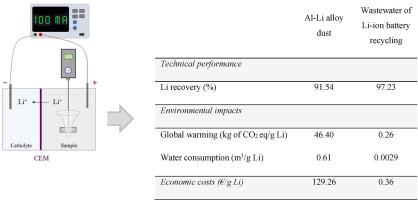二次资源电析提锂:技术、环境和经济评价
IF 5.8
2区 化学
Q2 CHEMISTRY, MULTIDISCIPLINARY
引用次数: 0
摘要
在交通运输领域,大规模电气化,特别是通过锂离子电池,预计将大幅减少排放,同时增加全球锂需求。然而,锂的有限供应,再加上地缘政治的限制,对能源转型构成了风险,特别是在欧盟。采用循环经济模式为增加资源回收提供了一种可持续的方法。本研究旨在评估电渗析工艺从锂离子电池回收和铝锂合金粉尘处理过程中产生的废水中回收锂的潜力,以及相关的环境和经济影响。实验采用双室电渗析反应器,在50 mA、100 mA和200 mA的电压下进行,并插入阳离子交换膜。在24 h、48 h和72 h进行试验,铝锂合金粉尘和锂离子电池回收废水的锂回收率分别达到91.54%和97.23%。从摇篮到闸门的生命周期评估结果显示,锂离子电池回收废水的CO2 eq/g Li全球变暖影响为0.26 kg,铝锂合金粉尘的CO2 eq/g Li全球变暖影响为46.40 kg。物料流成本核算显示,废水的回收成本较低(0.36欧元/克锂比129.26欧元/克锂)。反应器中的能源消耗是主要的热点,优化能源和时间效率可以减少对环境和经济的影响。本文章由计算机程序翻译,如有差异,请以英文原文为准。

Electrodialytic lithium extraction from secondary resources: Technical, environmental and economic assessment
In transportation, large-scale electrification, particularly through lithium-ion batteries, is expected to drive significant emissions reductions while simultaneously increasing global lithium demand. However, the limited availability of lithium, compounded by geopolitical constraints, poses risks to the energy transition, namely in the European Union. Adopting circular economy models offers a sustainable approach to increase resource recovery. The present research aims to assess the potential of the electrodialytic process for lithium recovery from wastewater generated during lithium-ion battery recycling and aluminium-lithium alloy dust processing, as well as related environmental and economic impacts. Bench-scale experiments were conducted using two-compartment electrodialytic reactors, operated at 50 mA, 100 mA and 200 mA with a cation-exchange membrane interposed. Tests were performed over 24 h, 48 h and 72 h. Lithium recovery reached 91.54 % from the aluminium-lithium alloy dust and 97.23 % from the wastewater of lithium-ion battery recycling. The cradle-to-gate life cycle assessment resulted in 0.26 kg of CO2 eq/g Li global warming impacts for wastewater of lithium-ion battery recycling, and 46.40 kg of CO2 eq/g Li for aluminium-lithium alloy dust. Material flow cost accounting showed lower recovery costs for wastewater (0.36 €/g Li versus 129.26 €/g Li). Energy consumption in the reactor is the primary hotspot, where optimizing energy and time efficiency could reduce environmental and economic impacts.
求助全文
通过发布文献求助,成功后即可免费获取论文全文。
去求助
来源期刊

Sustainable Chemistry and Pharmacy
Environmental Science-Pollution
CiteScore
8.20
自引率
6.70%
发文量
274
审稿时长
37 days
期刊介绍:
Sustainable Chemistry and Pharmacy publishes research that is related to chemistry, pharmacy and sustainability science in a forward oriented manner. It provides a unique forum for the publication of innovative research on the intersection and overlap of chemistry and pharmacy on the one hand and sustainability on the other hand. This includes contributions related to increasing sustainability of chemistry and pharmaceutical science and industries itself as well as their products in relation to the contribution of these to sustainability itself. As an interdisciplinary and transdisciplinary journal it addresses all sustainability related issues along the life cycle of chemical and pharmaceutical products form resource related topics until the end of life of products. This includes not only natural science based approaches and issues but also from humanities, social science and economics as far as they are dealing with sustainability related to chemistry and pharmacy. Sustainable Chemistry and Pharmacy aims at bridging between disciplines as well as developing and developed countries.
 求助内容:
求助内容: 应助结果提醒方式:
应助结果提醒方式:


